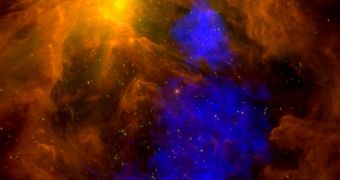Nebulae inside the Milky Way galaxy often receive high amounts of hot gas ejected by stars inside, which makes them emit radiation in the X-ray spectrum. Discovering these X-ray signatures could provide new information about young stars, which may hold secrets about the solar system and the planetary formation.
The Orion nebula is situated right below the stars that form the famous belt of the constellation Orion. It is the brightest nebulae, on the night sky, and probably the most photographed and scrutinized object, as it cradles multiple young stars and star forming structures, plus being an evidence of protoplanetary disks and brown dwarfs. Due to this fact, astrophysicists turned they eyes towards the dense cloud of turbulent gas, situated in the Trapezium, a formation of four bright stars in the Orion constellation, which illuminate the nebula.
Spectral X-ray analysis of the 10 light years wide nebula revealed that the cloud of hot glowing gas has an approximate temperature of 1,7 to 2,1 million degrees Celsius, that is abundant throughout the cloud. The only explanation for the seemingly wide cloud of super-heated gas is that it could have only originated from a supernovae explosion of a single supermassive star, or from successive explosions of a multiple collection of stars.
By using the XMM-Newton Space Observatory, an international team of astrophysicists, observing the nebula, revealed that the high amounts of hot gas seem to flow from only one direction, which points towards a young massive star inside the area of the Trapezium.
Although there are a lot of similar nebulae which spawn new stars across the Milky Way, very few are massive enough to give birth to very heavy stars. Orion nebula is notorious as being a stellar nursery, for thousands of new stars, nevertheless astrophysicists hope they will be able to find these X-ray emissions, in most or even in all of the star forming nebulae, to prove that they are relatively wide spread across the whole galaxy.
According to Manuel Gudel, from the Swiss Federal Institute of Technology in Zurich, our Sun might have formed in a similar nebula, thus by collecting information from the Orion nebula, we could be able to reveal and understand the origins of our Sun and of our solar system, and possibly, to find out how these X-ray emissions influence the process of planetary systems formation, and how they interact with the chemistry of these structures.

 14 DAY TRIAL //
14 DAY TRIAL //